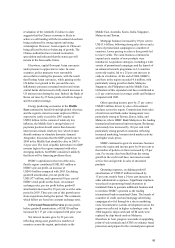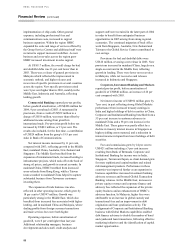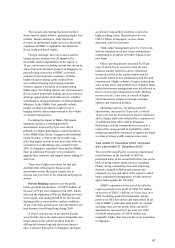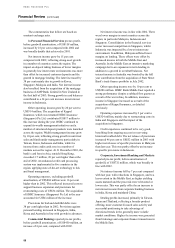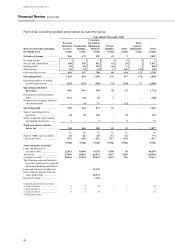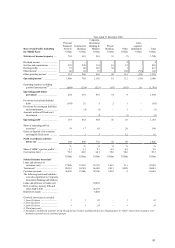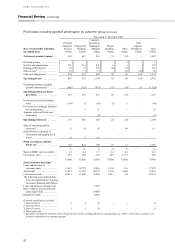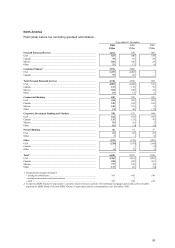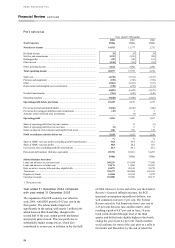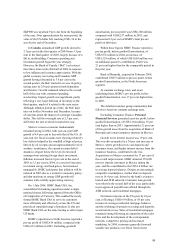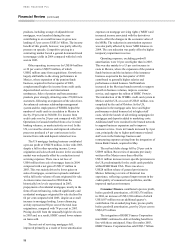HSBC 2004 Annual Report Download - page 97
Download and view the complete annual report
Please find page 97 of the 2004 HSBC annual report below. You can navigate through the pages in the report by either clicking on the pages listed below, or by using the keyword search tool below to find specific information within the annual report.95
S&P500 was up about 9 per cent from the beginning
of the year. Over approximately the same period, the
value of the US dollar fell, reaching US$1.36 to the
euro by the end of December.
In Canada, annualised GDP growth slowed to
2.7 per cent in the first quarter of 2004 from 3.3 per
cent in the final quarter of 2003, largely because of a
fall in stockbuilding. Consumer spending and
investment growth began the year strongly.
However, the Bank of Canada (‘BoC’ ) cut interest
rates three times in the first half of 2004 in response
to low inflation and currency appreciation. With the
global economy recovering and Canadian GDP
growth having rebounded to 3.9 per cent in the
second quarter, the BoC started to reverse its policy,
raising rates by 25 basis points in both September
and October. Growth remained robust in the second
half of the year with consumer spending
accelerating. Import growth was significant, partly
reflecting a very large build-up of inventory in the
third quarter, much of it related to the auto sector.
Although inflation picked up a little, the BoC kept
rates on hold in November and December, because
of concerns about the impact of a stronger Canadian
dollar. This left the overnight rate at 2.5 per cent,
still below the rate at which it started the year.
Mexico’ s macro-economic fundamentals
remained strong in 2004, with year-on-year GDP
growth of 4.4 per cent in line with that of the US. At
year-end, the fiscal accounts were showing relatively
low deficits helped by the windfall of high oil prices.
Driven by oil receipts and an unprecedented level of
workers´ remittances, the current account deficit
shrank to a figure below the level of reinvested
earnings from existing foreign direct investment.
Inflation increased from 4.0 per cent at the end of
2003 to 5.2 per cent in 2004, as a result of increases
in external energy and food prices, but remained
manageable. HSBC anticipates that inflation will be
reduced in 2005 due to a restrictive monetary policy,
and that moderate to strong GDP growth will
continue with a mildly appreciating currency.
On 1 July 2004, HSBC Bank USA, Inc.
consolidated its banking operations under a single
national charter, following approval from the Office
of Comptroller of Currency. This enabled the newly
formed HSBC Bank USA to serve its customers
more efficiently and effectively across the US and
provide an expanded range of products. It also put
HSBC Bank USA on the same footing as other major
US banks.
HSBC’s operations in North America reported a
pre-tax profit of US$5,419 million, compared with
US$3,613 million in 2003. Excluding goodwill
amortisation, pre-tax profit was US$6,180 million,
compared with US$4,257 million in 2003, and
represented 32 per cent of HSBC’ s total pre-tax
profit on this basis.
Within these figures HSBC Finance reported a
pre-tax profit, before goodwill amortisation, of
US$3,576 million in 2004, an increase of
US$1,524 million, of which US$1,084 million was
an additional quarter’ s contribution. Profit was
21 per cent higher than for the comparable period in
the prior year.
Bank of Bermuda, acquired in February 2004,
contributed US$73 million to pre-tax profit, before
goodwill amortisation, in the North American
segment.
At constant exchange rates, and on an
underlying basis, HSBC’s pre-tax profit, before
goodwill amortisation, was 17 per cent higher than
in 2003.
The detailed customer group commentary that
follows is based on constant exchange rates.
Excluding Consumer Finance, Personal
Financial Services generated a pre-tax profit, before
goodwill amortisation, of US$1,164 million, 35 per
cent higher than in 2003. Approximately 22 per cent
of this growth arose from the acquisition of Bank of
Bermuda and certain insurance interests in Mexico.
Growth in net interest income was 19 per cent.
This was driven mainly by a 34 per cent increase in
Mexico, where growth in low cost deposits and
consumer loans, and higher interest income from the
insurance business, contributed to the rise.
Acquisitions in Mexico accounted for 17 per cent of
the overall improvement. HSBC attracted 359,000
net new deposit customers in Mexico during the
year, and this contributed to the US$1.6 billion rise
in average deposit balances. Despite an increasingly
competitive marketplace, market share in deposits
rose to 14.4 per cent, driven by the bank’s extensive
branch and ATM network. Consumer loan growth
was robust in the second half of the year, particularly
in pre-approved payroll loans offered through the
ATM network, and residential mortgages.
Net interest income in the US grew by 10 per
cent, reflecting a US$10.9 billion, or 58 per cent,
increase in average residential mortgage balances
and the widening of spreads on savings and deposits,
as interest rates rose. Sales of residential mortgages
remained strong following an expansion of the sales
force and the development of the correspondent
network, competitive pricing and increased
marketing. In 2004, customers generally favoured
variable rate products over fixed. Several new


